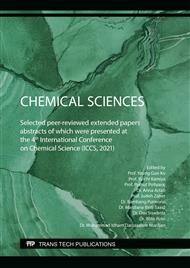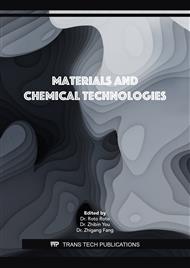[1]
C.J.L. Murray, L.C. Rosenfeld, S.S. Lim, K.G. Andrews, K.J. Foreman, D. Haring, N. Fullman, M. Naghavi, R. Lorenzo, A.D. Lopez, Global malaria mortality between 1980-2010: A systematic analysis, The Lancet 319 (2012) 413–431.
DOI: 10.1016/s0140-6736(12)60034-8
Google Scholar
[2]
World Health Organization (WHO), World Malaria Report, World Health Organization Press, Geneva, (2020).
Google Scholar
[3]
D. Rathore, D. Jani, R. Nagrakatti, S. Kumar, Heme detoxification and antimalarial drug – Known mechanisms and future prospect, Drug Discovery Today: Ther. Strategies 3 (2006) 153–158.
DOI: 10.1016/j.ddstr.2006.06.003
Google Scholar
[4]
N.T. Huy, D.T. Uyen, A. Maeda, D.T.X. Trang, T. Oida, S. Harada, K. Kamei, Simple colorimetric inhibition assay of heme crystallization for high-throughput screening of antimalarial compounds, Antimicrob. Agents Chemother. 51 (2007) 350–353.
DOI: 10.1128/aac.00985-06
Google Scholar
[5]
D. Fitriastuti, M.I.D. Mardjan, Jumina, Mustofa, Synthesis and heme polymerization inhibitory activity (HPIA) assay of antiplasmodial of (1)-N-(3,4-dimethoxybenzyl)-1,10-phenanthrolinium bromide from vanillin, Indones. J. Chem. 14 (2014) 1–6.
DOI: 10.22146/ijc.21260
Google Scholar
[6]
C. Surjadjaja, A. Surya, J.K. Baird, Epidemiology of Plasmodium vivax in Indonesia, Am. J. Trop. Med. Hyg. 95 (2016) 121–132.
DOI: 10.4269/ajtmh.16-0093
Google Scholar
[7]
N. Latifah, A. Subarnas, A.Y. Chaerunisaa, Antimalarial medicine and its mechanism: A review, Majala Farmasetika 5 (2020) 39–48.
DOI: 10.24198/mfarmasetika.v5i1.25927
Google Scholar
[8]
B. Kurniawan, N. Irawati, J.F. Suwandi, D.H. Tjong, Study of the K13 gene polymorphisms in Plasmodium falciparum in Pesawaran, Lampung, Indonesia, Pak. J. Biotechnol. 15 (2018) 871–874.
Google Scholar
[9]
S.Y. Prabawati, A. Mufidati, T.R. Djuwita, S.N. Nagini, Grinding technique on a synthesis of calixarene and its derivatives, EKSAKTA J. Sci. Data Anal. 1 (2020) 117–123.
DOI: 10.20885/eksakta.vol1.iss2.art4
Google Scholar
[10]
F.N. Pur, Calix[4]API-s: fully functionalized calix[4]arene-based facial active pharmaceutical ingredients, Mol. Diversity 25 (2020) 1247–1258.
DOI: 10.1007/s11030-020-10042-0
Google Scholar
[11]
E. Da Silva, A.N. Lazar, A.W. Coleman, Biopharmaceutical applications of calixarenes, J. Drug Delivery Sci. Technol. 14 (2004) 3–20.
DOI: 10.1016/s1773-2247(04)50001-1
Google Scholar
[12]
B. Mokhtari, K. Pourabdullah, Applications of calixarene nano-baskets in pharmacology, J. Inclusion Phenom. Macrocyclic Chem. 73 (2012) 1–15.
DOI: 10.1007/s10847-011-0062-z
Google Scholar
[13]
S. Kellici, J. Acord, A. Vaughn, N.P. Power, D.J. Morgan, T. Heil, S.P. Facq, G.I. Lampronti, Calixarene assisted rapid synthesis of silver-graphene nanocomposites with enhanced antibacterial activity, ACS Appl. Mater. Interfaces 8 (2016) 19038–19046.
DOI: 10.1021/acsami.6b06052
Google Scholar
[14]
R.B. Shah, N.N. Valand, P.G. Sutariya, S.K. Menon, Design, synthesis and characterization of quinolone-pyrimidine linked calix[4]arene scaffolds as antimalarial agents, J. Inclusion Phenom. Macrocyclic Chem. 84 (2016) 173–178.
DOI: 10.1007/s10847-015-0581-0
Google Scholar
[15]
N. Basilico, E. Pagani, D. Monti, P. Olliaro, D. Taramelli, A microtitre-based method for measuring the haem polymerization inhibitory activity (HPIA) of antimalarial drugs, J. Antimicrob. Chemother. 42 (1998) 55–60.
DOI: 10.1093/jac/42.1.55
Google Scholar
[16]
H.L. Qin, Z.W. Zhang, R. Lekkala, H. Alsulami, K.P. Rakesh, Chalcone hybrids as privileged scaffolds in antimalarial drug discovery: A key review, Eur. J. Med. Chem. 193 (2020) 112215.
DOI: 10.1016/j.ejmech.2020.112215
Google Scholar
[17]
E.L. Dodd, D.S. Bohle, Orienting the heterocyclic periphery: a structural model for chloroquine's antimalarial activity, Chem. Commun. 50 (2014) 13765–13768.
DOI: 10.1039/c4cc05328a
Google Scholar
[18]
D. Fitriastuti, T.S. Julianto, A.W.N. Iman, Identification and heme polymerization inhibition activity (HPIA) assay of ethanolic extract and fraction of temu mangga (Curcuma mangga Val.) rhizome, EKSAKTA J. Sci. Data Anal. 1 (2020) 64–72.
DOI: 10.20885/eksakta.vol1.iss1.art10
Google Scholar
[19]
P.M. O'Neill, V.E. Barton, S.A. Ward, The molecular mechanism of action of artemisinin-the debate continues, Molecules 15 (2010) 1705–1712.
DOI: 10.3390/molecules15031705
Google Scholar
[20]
R. Kumar, D. Mohanakrishnan, A. Sharma, N.K. Kaushik, K. Kalia, A.K. Sinha, D. Sahal, Reinvestigation of structure-activity relationship of methoxylated chalcones as antimalarials: Synthesis and evaluation of 2,4,5-trimethoxy substituted patterns as lead candidates derived from abundantly available natural 𝛽-asarone, Eur. J. Med. Chem. 45 (2010) 5292–5301.
DOI: 10.1016/j.ejmech.2010.08.049
Google Scholar



